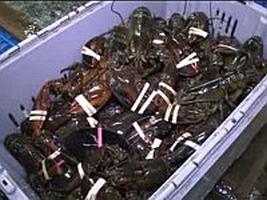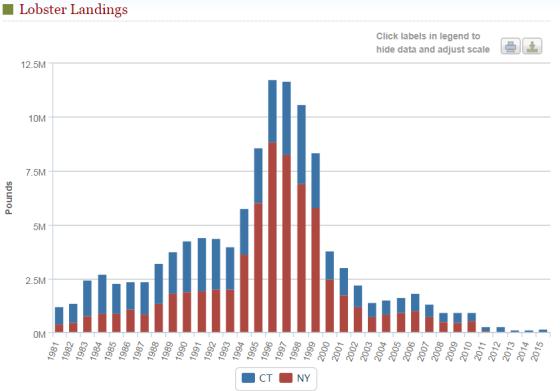 Today, the New York Times featured an article titled — “Climate Change Brought a Lobster Boom. Now It Could Cause a Bust.” The article suggests that while rising water temperatures due to climate change have brought a boom in the Maine lobster catch, increasing temperatures may lead to a collapse of the fishery. This concern is nothing new. Five years ago, we posted “The Ecology and Economics of Lobster – Will The Maine Lobster Boom End in a Bust?” Increasingly, the signs of a bust are becoming more ominous.
Today, the New York Times featured an article titled — “Climate Change Brought a Lobster Boom. Now It Could Cause a Bust.” The article suggests that while rising water temperatures due to climate change have brought a boom in the Maine lobster catch, increasing temperatures may lead to a collapse of the fishery. This concern is nothing new. Five years ago, we posted “The Ecology and Economics of Lobster – Will The Maine Lobster Boom End in a Bust?” Increasingly, the signs of a bust are becoming more ominous.
The NYTimes quotes Dave Cousens, who stepped down as president of the Maine Lobstermen’s Association in March, “Climate change really helped us for the last 20 years.” But, he added, “Climate change is going to kill us, in probably the next 30.”
The Times also notes that “the Gulf of Maine has warmed faster than 99 percent of the world’s oceans for much of this century, driven by climate change in combination with natural variation. By 2050, that warming could cut lobster populations in the gulf by up to 62 percent, the Gulf of Maine Research Institute says.”
As we wrote in our 2013 post: Maine has been experiencing a lobster boom. After catching an average of 20 million pounds of lobster per year for decades, Maine’s 5,500 lobster-men landed a record 125 million pounds of lobsters last year. Will this boom, however, end in a bust? … The question is important because the other ground fisheries in the Gulf of Maine; cod, haddock, pollock and hake; have been effectively fished out. Lobster accounts for 80% of the total value of the Maine fisheries. If lobster yields drop dramatically, the economic impact on the coast could be dire.
The prospect of a lobster fisheries collapse is not wholly hypothetical. The lobster fishery in Long Island Sound went through a similar boom and bust cycle in the 1980s through 2013, when lobster fishing was suspended to attempt to preserve the few lobsters remaining.
Beginning in the 1980s, lobster harvest significantly increased in Long Island Sound, with the peak occurring in 1997. Catches rose from around 2.5 million pounds in the 1980s to almost 12 million in 1997. Then in 1999 lobsters began to die off, most severely in the western Sound, reducing the harvest to early 1980s-levels. Then around 2010, the lobster population collapsed. The 2014 harvest was less than one-tenth the average harvest landed in the 1980s, and only about 1% of the peak values observed in the mid 90’s. Scientists concluded that a combination of warmer temperatures and impaired water quality stressed lobsters, making them susceptible to disease and limiting their ability to reproduce, which caused a rapid drop in the population. Today the lobster population in Long Island Sound is barely holding on.
Will the Maine lobster population avoid the same fate as that of the Sound’s? The good news is that the geography and water quality issues are not the same in Maine as that of the Long Island Sound at the turn of the century. As waters warm, the lobsters may move to deeper waters offshore, which was not an option in the geographically bounded Long Island Sound. Also, Maine lobstermen practice strict rules to conserve and protect undersized and egg-bearing lobsters.
Will it be enough? No one really knows. Curtis Brown, a lobsterman and marine biologist for Ready Seafood sums it up, saying, “We have a multimillion-dollar industry and a woefully inadequate understanding.”


Don’t forget the new 25% tariff just announced to be placed on lobster imported to China. However Right Whales do get tangled in lobster and snow crab gear…………..I fear that the Right Whale will be extinct in my lifetime (and I am elderly).
“Right Whales do get tangled in lobster and snow crab gear”?
Really?
How do they fit in the little lobster pots/crab traps?
If the water gets too warm for lobsters, they will move to cooler waters, either north or to deeper water.
o not forget that there is still a lot of pollution in the Long Island Sound. The cities still dump raw sewage into the waters (they say the sewage is treated but when it rains all of the cities around the sound divert the sewage). Also, starting in the late 1980’s and 1990’s a lot of spraying for west Nile virus carrying mosquitoes was done. This also had a bad effect on the shellfish larva. This coupled with a tremendous amount of over fishing appeared to wipe out the fishery. I am not nor do I claim to be a fishery expert. This is just my observations and reports from local papers.
There was a joke about Maine in 1997. Seems that Maine would curb lobster fishing by buying up lobster gear so lobstering persons would get training and do other proffessions. Well that was the theory. Instead what the industry realized was you could spend 2 grand buying a boat that no longer floated, go to a antique store and buy up all their useless old traps. Take that inventory to the government and they would give you enough money to buy a new boat and better gear. So instead of curbing the harvest, the government encouraged fishing at three times the level of damage than before!
Now supposedly there are hatcheries that figured out how to get lobsters to grow in hatcheries. Before it couldnt be done. Now supposedly a hatchery can grow a lobster to under the size of legal catch (to release them and regrow the population). Tho the industry is catching on to this as well and pitch their traps near the hatcheries so they dont need to fish as hard.
Its a wonderful life in Maine. Isnt it?
I anticipate that unless the catch is regulated all the Maine lobsters will be hoovered up by over-zealous fishing fleets long before the lobsters find the water too warm.
Agreed. The canadians have no size or catch limits. The grand daddy lobsters or tthe notched tail female are off limits in Maine. But not to the canadians.